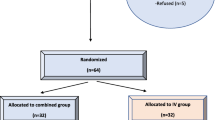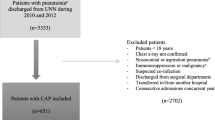Abstract
Objective: To compare the efficacy of sequential injectable crystalline penicillin (C.pen) and gentamicin combination followed by amoxicillin with sequential IV and oral amoxicillin-clavulanate (amox-clav) in treatment of severe or very severe hypoxemic pneumonia.Methods: Children aged 2–59 months with WHO-defined severe or very severe pneumonia with hypoxemia (SpO2<90%) were included in the study. Patients with fever>10 days, bacterial meningitis, prior antibiotic therapy >24 hours, stridor, heart disease and allergy to any of the study drugs were excluded. They were randomly allocated to two groups—Group A and Group B. Group A received C. pen and gentamicin intravenously (IV), followed by oral amoxicillin and group B got amox-clav IV, followed by oral amox-clav. Minimum duration of IV therapy was 3 days and total 7 days. Respiratory rate, oxygen saturation and chest wall indrawing were monitored 6 hourly.Results: 71 patients were included. There were two (5.2%) blood cultures positive in group A and three (9%) in group B. Organisms isolated wereS. pneumoniae (n=3) andH. influenzae-b (n=2). There was only one treatment failure in each of the groups. One was due to penicillin resistantH. influenzae-b and the other was due to worsening of pneumonia. The mean time taken for normalization of tachypnea, hypoxia, chest wall indrawing and inability to feed was similar (P-N.S). Mean duration of IV therapy in group A was 76±25 hrs and group B was 75±24 hrs (p>0.1).Conclusion: In children of 2–59 months, sequential injectable C. pen and gentamicin combination, followed by oral amoxicillin or sequential IV and oral amox-clav were equally effective for the treatment of severe or very severe hypoxemic community acquired pneumonia.
Similar content being viewed by others
References
Cherian T. Acute respiratory infections in developing countries: current status and future directions.Indian Pediatr 1997; 34: 877–884.
Shann F. Etiology of severe pneumonia in children in developing countries.Pediatr Infect Dis J 1986; 5: 247–252.
WHO. Programme for control of acute respiratory infections.Acute Respiratory Infections in Children: Case Management in a Small Hospital in Developing Countries—A Manual for Doctors and Senior Health Workers. Geneva WHO/ARI/90.5.
Vuori-Holopainen E, Peltola H. Reappraisal of lung tap: Review of an old method for better etiologic diagnosis of childhood pneumonia.Clin Infect Dis 2001; 32: 715–726.
World Health Organization. Acute respiratory infections: The forgotten pandemic.Bull WHO 1998; 76: 101–103.
McCracken GH Jr. Etiology and treatment of pneumonia.Pediatr Infect Dis J 2000; 19: 373–377.
McCracken GH Jr. Diagnosis and management of pneumonia in children.Pediatr Infect Dis J 2000; 19: 924–928.
Korppi M. Community acquired pneumonia in children.Pediatr Drugs 2003; 5: 821–832.
Juven T, Mertsola J, Waris Met al. Etiology of community acquired pneumonia in 254 hospitalized children.Pediatr Infect Dis J 2000; 19: 293–98.
Kosma H, Korppi T, Jokinen Met al. Etiology of childhood pneumonia: Serologic results of a prospective, population based study.Pediatr Infect Dis J 1998; 17: 986–991.
McIntosh K. Community acquired pneumonia in children.N Engl J Med 2002; 346: 429–437.
Kumar L. Severe acute lower respiratory tract infection. Etiology and management.Indian J Pediatr 1987; 54: 189–98.
Tan TQ, Mason EO Jr., Barson WJet al. Clinical characteristics and outcome of children with pneumonia attributable to penicillin susceptible and penicillin-non-susceptible Streptococcus pneumoniae.Pediatrics 1998; 102: 1369–1375.
Pallares R, Linare J, Vakillo Met al. Resistance to Penicillin and cephalosporin and mortality from severe pneumococcal pneumonia in Barcelona, Spain.New Engl J Med 1995; 333: 474–480.
MC Gowan JE Jr and Metchock BG. Penicillin-resistant pneumococci-an emerging threat to successful therapy.J Hosp Infection 1995; 30 (suppl): 472–482.
Wubbel L, Muniz L, Ahmed Aet al. Aetiology and treatment of community acquired pneumonia in ambulatory children.Pediatr Infect Dis J 1999; 18: 98–104.
Heiskanen-Kosma T, Korppi M, Tokinen Cet al. Aetiology of childhood pneumonias: serologic results of prospective, population-based study.Pediatr Infect Dis J 1998; 17: 986–991.
Singhi S, Jain V and Gupta G. Pediatric emergencies at a tertiary care hospital in India.J Trop Ped 2003; 49: 207–211.
Kumar L, Kumar V, Mitra SKet al. Staphylococcal lung disease in children.Indian Pediatr 1974; 11: 793–797.
Rasmussen Z, Pio A and Enarson P. Case management of childhood pneumonia in developing countries: recent relevant research and current initiatives.Int J Tuberc Lung Dis 2000; 4: 807–826.
Easton J, Noble S and Perry CM. Amoxicillin/Clavulanic acid: A review of its use in the management of pediatric patients with acute otitis media.Drugs 2003; 63: 311–340.
Author information
Authors and Affiliations
Corresponding author
Rights and permissions
About this article
Cite this article
Bansal, A., Singhi, S.C. & Jayashree, M. Penicillin and gentamicin therapyvs amoxicillin/clavulanate in severe hypoxemic pneumonia. Indian J Pediatr 73, 305–309 (2006). https://doi.org/10.1007/BF02825824
Issue Date:
DOI: https://doi.org/10.1007/BF02825824




